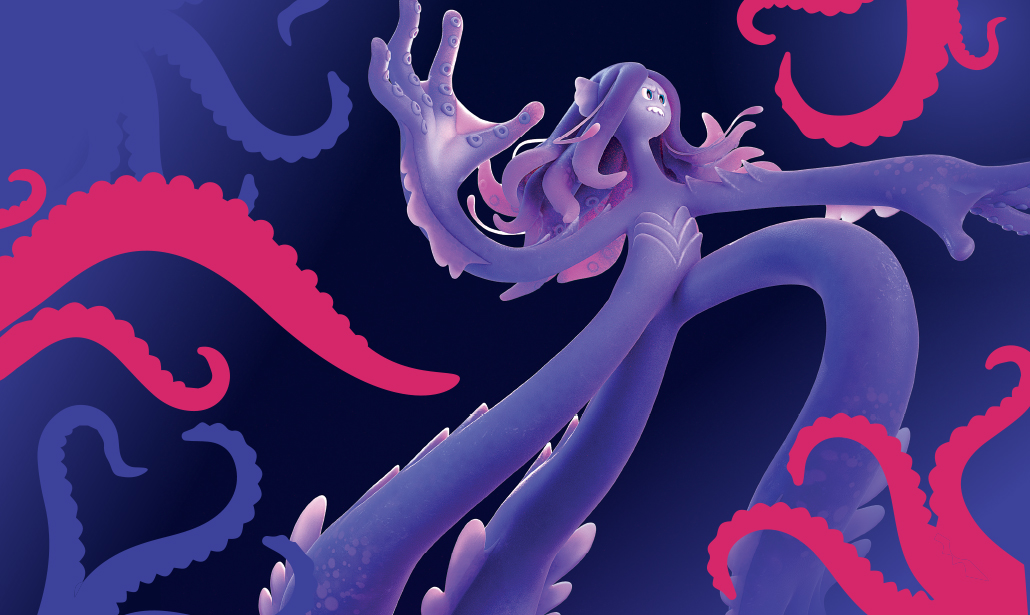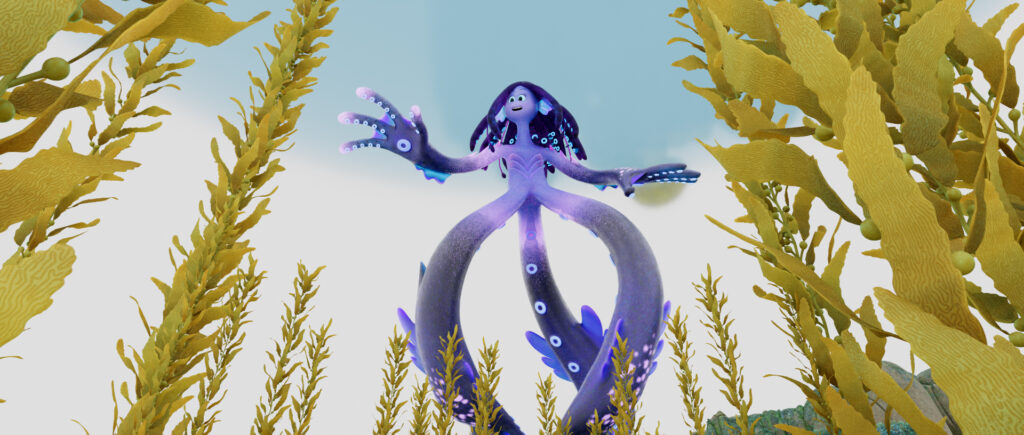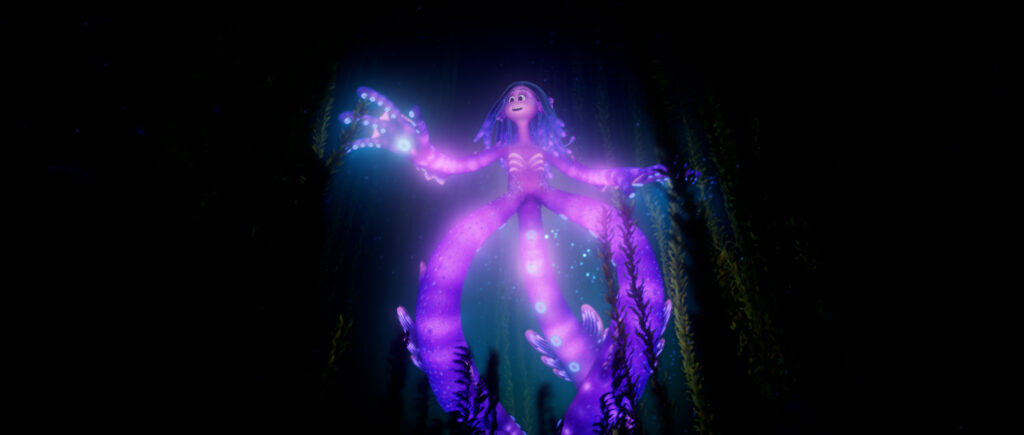What do you do when your title character is a kraken? You turn the sea monster trope upside down and transform a mythical beast into a teenager trying to fit into high school. Ruby Gillman, Teenage Kraken centers on the relationship between Ruby and her mother, Agatha, who has transplanted her family to a quirky seaside town and tasked them to blend in by claiming they’re from Canada. No easy feat since they are blue, squid-like creatures. The one major rule: stay away from water because of its hidden dangers.
Ruby dutifully obeys her mom until faced with the prospect of attending high school prom with her crush, Connor. The event takes place on a ship, which would break her mother’s cardinal rule. As Ruby tests teenage boundaries, she unveils a family secret that makes her question her mother and sets her on a journey of self-discovery. The film may be a heartwarming coming of age story, but it’s the visual FX that are integral in capturing her transformation.
Glow Up
During a promposal mishap, love interest Connor accidentally gets knocked into the ocean. Ruby is faced with a conundrum—go against her mother’s rule to avoid water or jump in to try and save him. She dives in. As she sinks to the bottom of the ocean, her lungs fill with saltwater and the giant kraken inside of her is awakened. She begins to glow and transforms into the sea creature.
The artists on the project refer to this transformation as the kraken’s activated form, a translucent bioluminescent glow that radiates from inside the body. Turning the character essentially into a light source demanded a close collaboration between lighting and FX.
“We provide a 3D map to lighting so they can illuminate the progression of what’s going on,” says Lawrence Lee, Head of FX. This map consisted of volumetric data that directed when and where to activate lights on the character’s body.
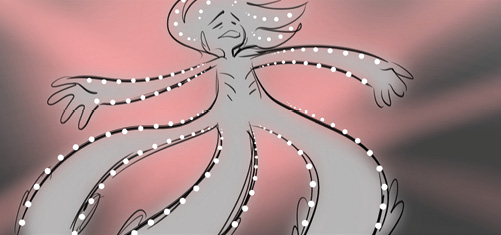
It allowed the lighting department to create “the effect of the glowing [path] starting from the hand and then traveling up the body,” says Joanna Wu, Head of Lighting. Plus, Ruby’s activated form radiates light on objects and characters around her. The pink light casts a flattering glow on other characters and creates an intentional connection between them, says Wu. Plus, her energy affects environments and locations like an underwater castle, which reacts to her presence by glowing pink.
When Ruby first transforms into a kraken, the energy she emits in the ocean draws the attention of her estranged grandmother. Ruby learns that she and her mother are part of kraken royalty tasked with protecting the seas from evil enemies, including Nerissa, a mermaid who stole a magical trident that transformed her into a threatening titan. Grandmamma shares with Ruby that many years ago her mother battled Nerissa and hid the powerful weapon inside a magnetic volcano for safekeeping before escaping from the kraken kingdom onto dry land.
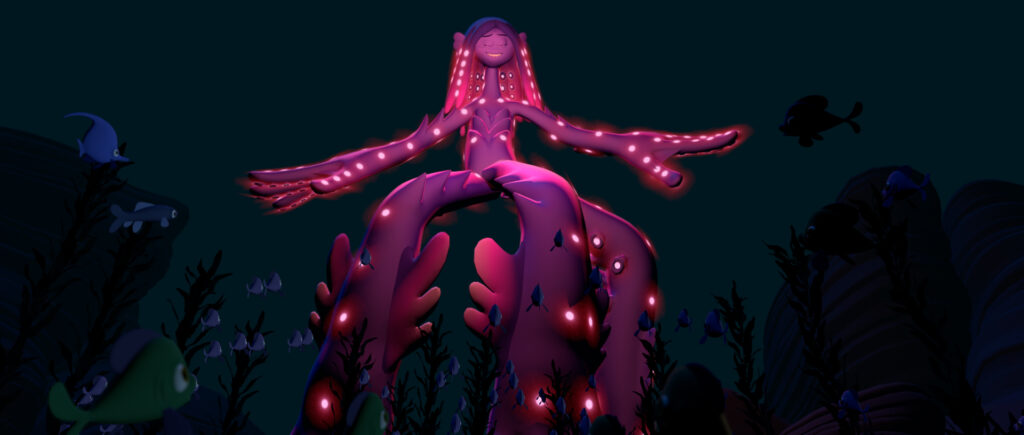
Go with the Flow
Ruby believes that the trident is the key to restoring peace in the kingdom (and her family) and vows to find it. But where do you hide an all-powerful weapon that can grant almost invincible power? “It couldn’t be behind a wall with a lock on it,” says Director Kirk DeMicco. “We had to work with FX in creating obstacles and environments that lived up to a giant kraken.”
Production Designer Pierre-Olivier Vincent was intrigued by dramatic underwater volcanos and used the idea as a starting point. “Sea creatures perceive their environment slightly differently,” he says. “They can find their way according to magnetism.” So he coupled the idea of forceful magnetic currents with an underwater volcano to provide a training ground for Ruby to test her powers and learn how to use them, all while trying to retrieve the trident.
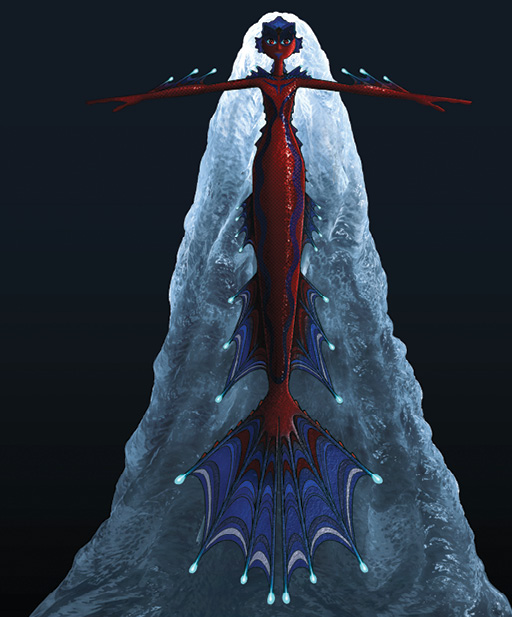
“It could be really cool to visualize those incredible flows,” Vincent says, like flares on the surface of the sun, while also embracing the poetry and scale of the cosmos. “There was that foreboding feeling of immensity, danger, and also beauty combined together.”
“Ruby dives into the currents and interacts with them,” says Lee, so FX Supervisor Derek Cheung had to build curves that essentially bent around the character as she battles through them to reach the center of the volcano, almost like a heat shield. Lee and the FX team turned to real-life inspiration watching the way smoke filters around airplanes in wind tunnels. Cheung attached volumetric elements to the character’s animation paths to generate the currents around Ruby and make it appear as if she is meeting resistance.
The currents get more chaotic as Ruby gets closer to the center of volcano, and the ripples mimic the shape language of the entire film. Inspired by the psychedelic era and graphic designer Milton Glaser, Vincent incorporated curvy design concepts from that era that were playful and colorful throughout the film, and FX used the shape language to stylize the currents. Vincent had a color palette in mind, so the FX team followed his suggestions and created a randomized pattern that cycled through the colors and could be adjusted in terms of brightness by the lighting department.
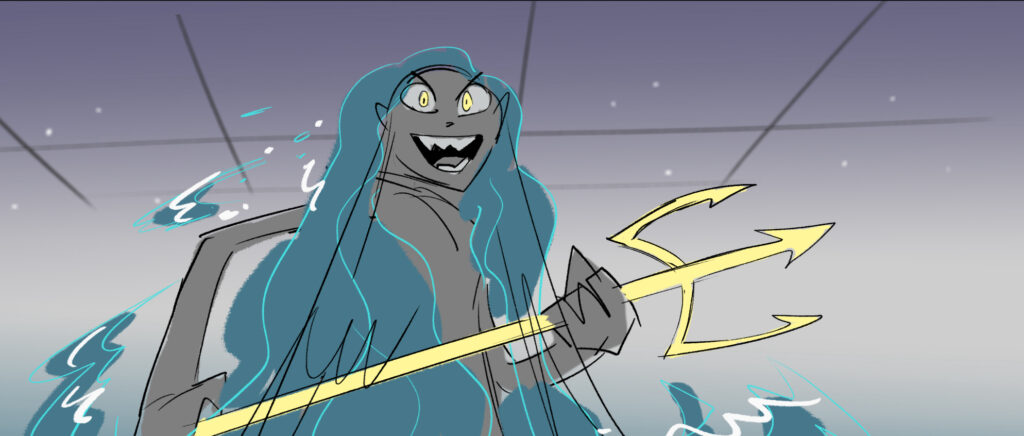
Waves of Fury
Mermaids are often depicted as temptresses luring doomed sailors with their siren call, and this film taps into the mythological creature’s dark side with the return of Nerissa and a plot twist that pits her against the krakens in a Pacific Rim-style, kaiju battle.
Water interactions at this large scale are always challenging and expensive, but the filmmakers also envisioned the sequence to be balletic and elegant, adds DeMicco. “We wanted an element of surprise,” adds Vincent. Using water as a dramatic statement, he envisioned Nerissa as drawing power from the ocean to create waves of turbulent water hair.
“We’re helping them conceptually,” says Vincent, “but FX is such a powerful department, dealing with all the reality of that element and calibrating it to our needs. It looks a little bit like magic.”
The FX team faced three main challenges transforming Nerissa into a fighting titan with cascading hair. The character is a 300-foot mermaid half submerged in water that can travel at speeds of over 100 mph, says FX Supervisor Mark Newport of the first challenge to address the scale and the speed. Next, they had to create the appearance of water being sucked up into her hair that is also illuminated from an internal glow. The third challenge was the sheer number of shots, about 71, ranging from close-up headshots to full body fighting interactions.
The solution was a multi-technique approach. The modeling department created a tubular structure for the overall shape of the hair, then Character FX ran a soft body simulation to give the hair weight and scale, and a more flowy feel. Next, Newport applied some procedural ridges to the hair to make it appear more like strands. They needed to essentially bundle strands of hair together, and in order to do so, Research and Development developed a new filleting tool that creates a smooth curve shape between two angles to look like “they’re joining together rather than being a sharp disconnected angle,” says Newport.
Once the overall geometry of the hair was finalized, they turned their attention to the material qualities to make it react like water but also reflect the concept of glowing hair. The geometry mesh was transparent; while the internal volume had two fields, a density field that essentially absorbed and scattered the light to make it appear to glow brighter at the scalp and an incandescent field that emitted light.
Newport generated a curve through the center of the hair bundles that was used like a suction force in the fluid simulation in order to make it appear as if the energy of the ocean was being sucked into their hair. A churning force was applied to generate more white-water foam around the base of the hair to integrate more seamlessly with the ocean. Other volumetric paths included two different kinds of foam and two different types of spray. The spray needed to both tear away from the body and travel with the character.
As the titan mermaid battles, she makes some fast, sweeping motions. In the real world, the spray would fall almost like a curtain of water, but in the film it had to also travel with her. Newport created a local spray that would essentially stay with the character as she moved, while the world spray could tear away from her body. The spray simulation had a corresponding mist element “to basically represent fine water particles that kind of vaporized almost like a waterfall type effect. So, you’ve got local spray and then you’ve got a volumetric mist,” says Newport.
The tools that Newport set up would get the FX artist working on the shot about 75 to 80 percent there, but then controls allowed for customization. For example, at Nerissa’s speed and scale in the fighting sequences “she just ends up becoming a big ball of spray,” says Newport. The controls made it easier for the FX team to clear out the face so it wouldn’t be covered by spray and water that might be accurate to real-world physics but not necessarily aesthetically pleasing.
For lighting, the glowing water hair became a key source of light, not only illuminating Nerissa’s skin but lighting up the surrounding area, much like Ruby does when she’s in the kraken’s activated form. The light is brightest at the scalp, illuminating the churning white spray; it then turns into a blue cyan color as it gets closer to the ocean and connects with the water in a continuous stream, says Wu.
“Water is interesting because there is that self-illuminating property of the material,” she adds. Normally, lighting would create the glow-like appearance, but in this case FX set up the material properties with an internal glow to create the path of illumination. The FX team provided lighting with controls to allow the artists to determine how far up or down the brightness would travel through the hair.
This modular approach throughout the film turned kraken-sized challenges into manageable solutions that embodied the vision of the filmmakers. Adds DeMicco: “I’m sure [the FX artists] were worried, but I wasn’t worried because I think they’re geniuses and they can do anything. It’s like wizardry.”
